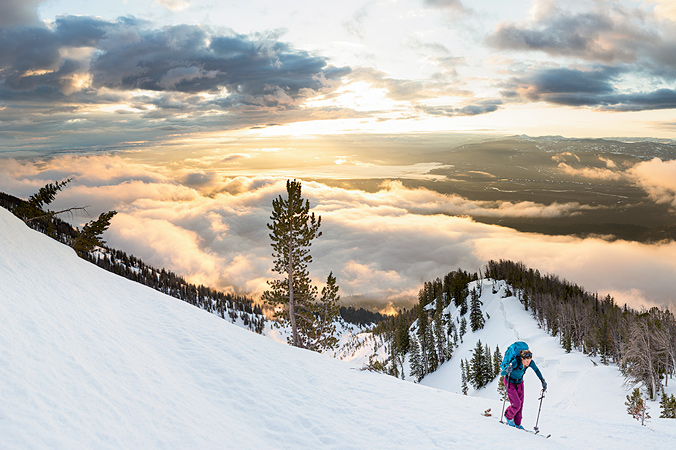In 2014, when Exum guide and longtime skimo competitor Janelle Smiley entered a hospital for double hip surgeries, she worried she might never skin again. She and her husband Mark, an internationally certified mountain guide, had built a life around uphill skiing—Janelle is a three-time winner of the National Skimo Championship, a two-time North American Championship winner and won the team division of the 2013 Swiss Mountaineering Championship with partner Stevie Kremer. But with two torn hip labrums, the rubbery tissue surrounding the hip socket, she found that her discomfort when skinning had reached an unmanageable level.
Once on the mend, Smiley felt optimistic about getting back in the skintrack but knew that a pain-free future required more than just regular physical therapy; it meant understanding how to prevent similar injuries in the future. Her first step toward prevention involved meeting with Jackson Hole, Wyo.-based certified strength-and-conditioning specialist Chris Butler.
After a few visits with Butler, Smiley learned that her labrum tears resulted from overdeveloped quads, or as Butler puts it, “underdeveloped hamstrings and glutes.” He explains that this is a common issue with endurance athletes who regularly hit the skintrack. Every person has unique physical limitations, but tight hips and weak hamstrings are a ubiquitous complaint in the skiing world, and Smiley’s story warrants a deeper look into the common mechanical problems that tourers face and how to prevent skintrack-induced pain.

Janelle Smiley focuses on her core principles. Teewinot Mountain, Wyo. [Photo] Mark Smiley
Be Efficient
Improper skinning form places undue stress on the hips. And, as Butler explains, “If you focus on driving your heel down [similar to a running heel strike] instead of leading with your toe, you can load your glutes for a stronger, more powerful step.” This heel-focused stepping movement can help fix the common mistake of dragging skis from the hip with each step. And with big objectives in mind, using gear appropriately can be more efficient than a fast pace. “Form follows function,” Butler adds. “If you focus on form, you’re going to be more efficient.”
Smell the Roses
In the rat race of life, it can be hard to slow down, but Butler suggests cooling your jets to achieve efficiency and ease on the skintrack. “Slow is smooth, and smooth is fast,” he pronounces. While an STFU (straight the eff up) route can be appealing for the time-sensitive set, it can have negative effects on both joint function and general skintrack enjoyment. “If you crush yourself going up, you’re not really maximizing your way down,” Butler says. “I’m in it for the powder turns.”
Drink to Your Health
“Hydration is key,” says Turner Moyse, a Revelstoke, B.C.-based training specialist and co-founder of the remote training program Train 2 Ski. “Water is essential to maintain blood volume, regulate body temperature and allow muscle contractions to take place. Reducing the amount of water available to the body means the body will not perform at its optimum level.” Moyse suggests starting the day with a glass of water before or in addition to morning coffee and recommends warm drinks, like tea or hot water with ginger and lemon, over cold water, to encourage skintrack hydration. “Once you’re thirsty, you’re already dehydrated,” he says. “Clear pee’er, happy skier.”
Core Concepts
“Half the reason I started my facility is because I was having chronic back pain while skinning and bootpacking,” says Freeskiing World Tour champion and Wright Training founder Crystal Wright. “For skinning I recommend strengthening glutes, but I love the FIRE technique which involves working the core through flexion, isometric, rotational and extension exercises.” But, Wright points out, sculpted abs and a strong back are not the only factor promoting longevity: “If you are firing on all cylinders—using your glutes, hamstrings, core and quads together—all your muscles work the motion and, in turn, you’re less likely to suffer an injury.”
Fonda’s Foundation
Skinning technique may not have exactly been what the ’80s fitness diva had in mind with her exercise videos, but Train 2 Ski’s Moyse suggests that butt building is important for overall strength. “One of the major implications of desk jobs is that our glutes have switched off,” he says. “In our experience, 80- to 90-percent of clients have a hard time switching glutes on after being sedentary.” Butler reiterates this point with a suggestion: “Avoid sitting on furniture. Sit on the floor before you sit at a desk.”
Build Your Core
Here it comes, the dreaded three-letter word: Gym. While you might have reservations about pumping iron with dudes who resemble youthful Arnold Schwarzeneggers, strength building doesn’t have to be a testosterone-fueled experience. “What you need to do is build a bigger, better, stronger engine in the gym and then utilize that when you’re doing your chosen activity,” Butler stresses. “That’s also how you prevent injury.” Wright agrees, explaining that her goal for outdoor athletes is “to make them stronger and more durable in the mountains.”










I developed early osteoarthritis of both hips and had them replaced at age 35
At the time I thought I was done going backcountry but how wrong I was
My titanium hips have been going strong for 18 years and have clocked up countless miles and days in the hills
A positive mindset and can do attitude couple with the right exercises is key to recovery and longevity
With winter around the corner I can’t wait to get back into it
Curious, what is the FIRE technique?